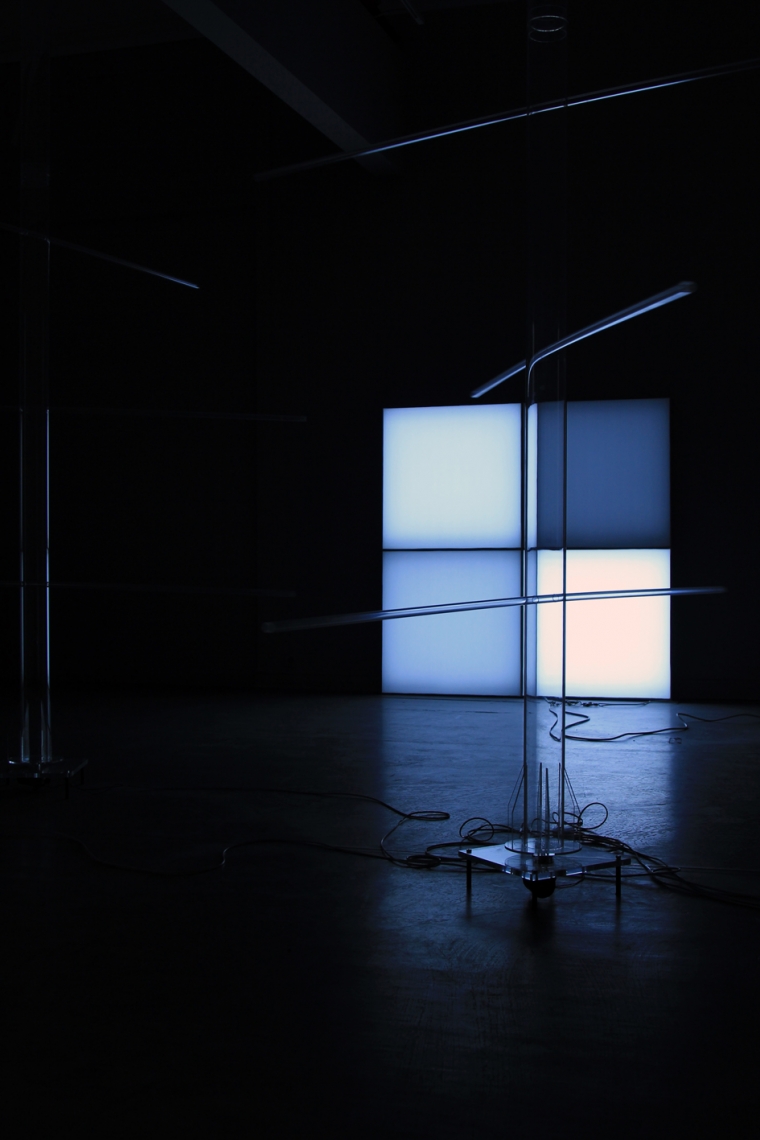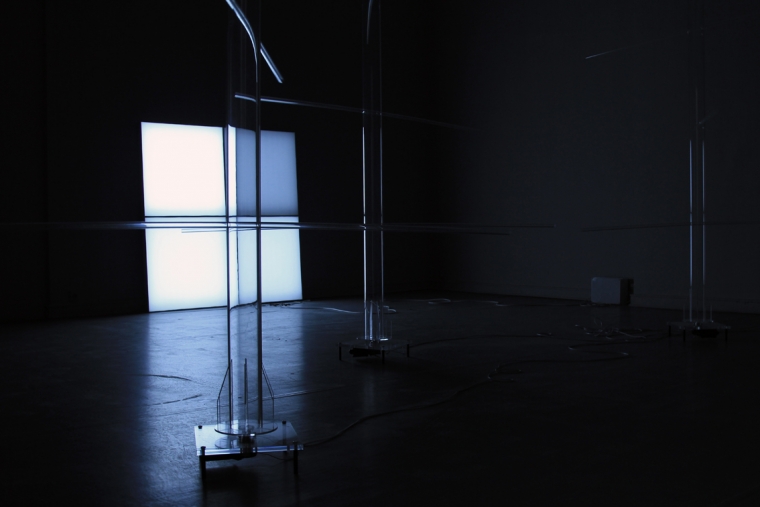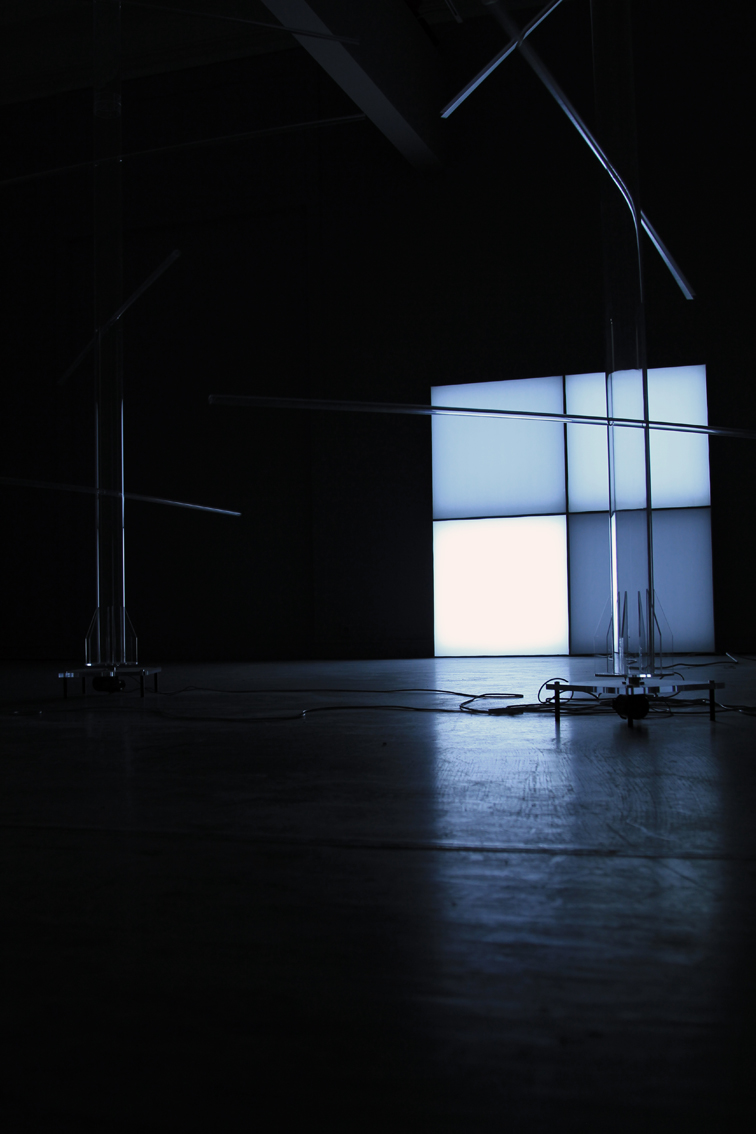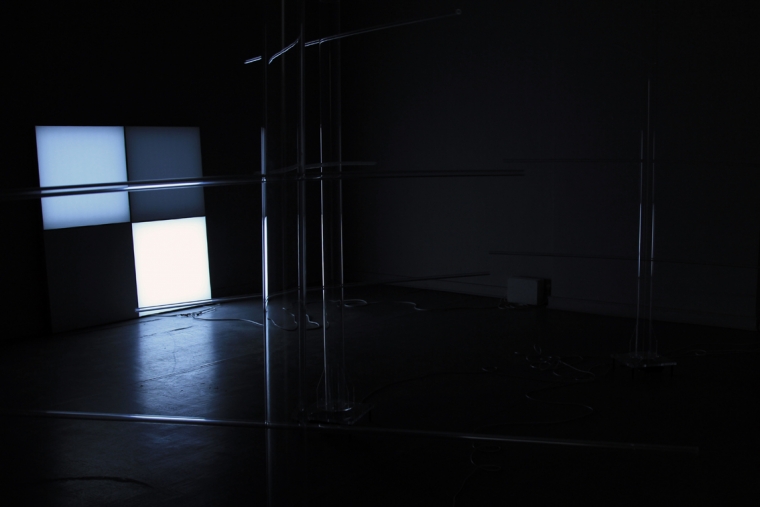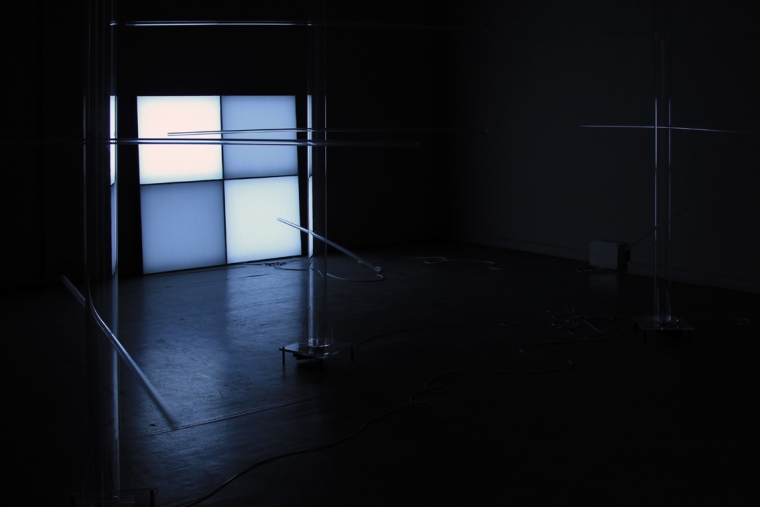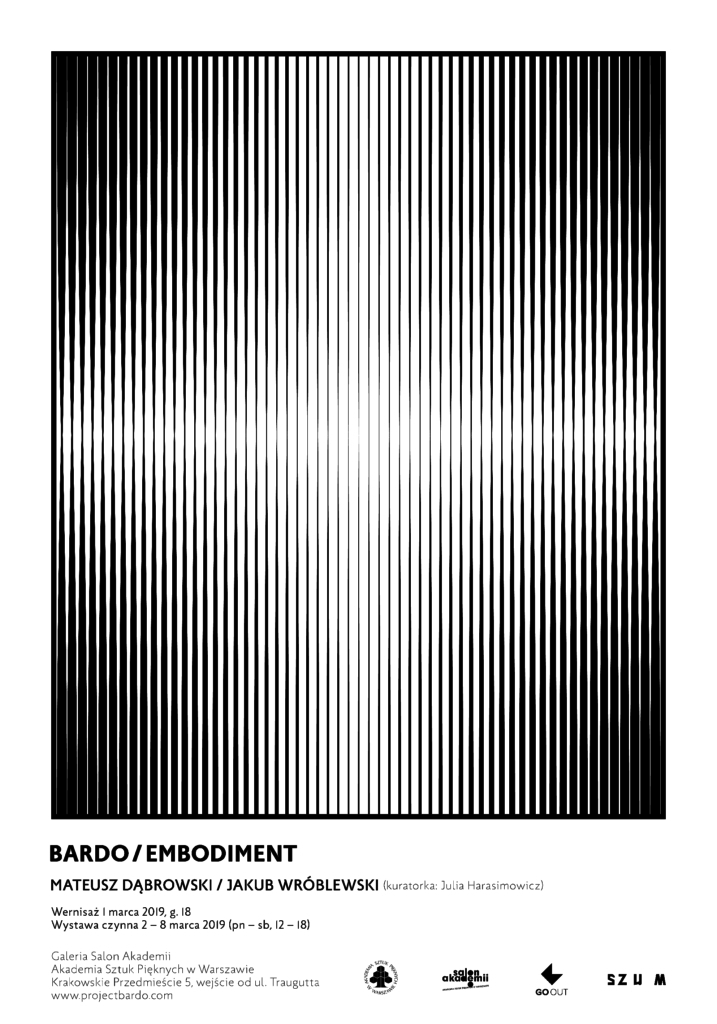
design Mateusz Machalski
BARDO vol3 EMBODIMENT/ Mateusz Dąbrowski, Jakub Wróblewski
SALON AKADEMII GALLERY
01/03 – 08/03/2019
curator Julia Harasimowicz
Bardo (skt. antarabhava; Wylie: bar do) – literally translated is an intermediate state. A Tibetan Buddhist term for any transitional state of existence: life, meditation, sleep, death. Most commonly used to refer to the intermediate state between death and subsequent birth.
The artistic and research project Bardo, led by Mateusz Dąbrowski and Jakub Wróblewski since 2013, refers to popular terms from the borderline of science and intellectual fashions during successive instalments. The artists have developed a particular model of collaboration. They always create two autonomous projects, connected by the exhibition space and the leitmotif. Embodiment is the third instalment of the series, created after a six-year break from showing the previous one. The title of the latest presentation, which is not fully translatable, can be widely translated as embodiment or embodiment.
The show at the Academy Salon is a summary not so much of the project itself, but above all of the two artists’ recent formal explorations, which have allowed them a new quality of interpretation of the chosen slogan. More than intellectual analysis, they are more concerned with the audience’s affective contact with the resulting works.
Mateusz Dąbrowski continues his search for movement and technique. The artist’s starting point is a reflection on the nature of technology, in which he tries to go beyond thinking in terms of nature-culture oppositions and looks for universal commonalities. He focuses on the meaning of the term embodiment and embodiment itself, and analyses the possibility of translating ideas into matter.
Jakub Wróblewski explores the issue of embodiment through an interactive VR experience. The result of his reflections is a play with the almost classic transhumanist fantasy of life extension through the virtual world. The artist refers to the genesis of the project, the Tibetan bardo, as a space for the individual experience of death. The designed action requires the viewer to participate fully and alone in the virtual reality. The artists have entirely renounced any attachment to a specific medium and focus on inducing a sense of suspension in the viewer.
Julia Harasimowicz
Mateusz Dąbrowski continues his search related to the movement and technology, initiated in 2018 at the exhibition Caterpillar at the Zachęta Project Room. The starting point for the artist is the reflection on the nature of technology, in which he tries to go beyond thinking in the nature-culture oppositions, Dąbrowski looks for universal common features. In Salon Akademii he focuseson the meaning of the very term of incarnation and embodiment, analyses the possibilities of putting the idea before matter. The most important means of presenting these concepts are two physical phenomena – light and motion. For Dąbrowski, an object is the embodiment of an idea, but the visual form will always in a way remain a simplification.
1 Andrew D. Wilson, Sabrina Golonka, Embodying cognition is not what you think, transl. Monika Włudzik, Przemyslaw Nowakowski, ‘Avant’ 2014, vol. 1, no. 1, p. 22.
Dąbrowski divides the gallery space into zones. In the first of them, there are irregular objects with a crystal structure. Synthetic materials and a form referring to nature make the object unobvious. Vertical forms move in a mechanical way, like a cogwheel, but theyare not without small suspensions and delays. So, the artist points out that the monotonous rhythm refers to the dynamics seen in nature. Objects also make the viewer to interact with motion, to take the right pose to pass them or passively observe them from a safe distance. They also form a kind of obstacle ahead of the next zone where the light installation Timeline is located. Lightboxes shine in a variable and rapidly changing rhythm. The author says: “There is no fixed point, […] there is a new relationship between the elements. It is impossible to actualize the idea in it. This object cannot be embodied. I am interested in the fragmentary nature and the failing thoughts of something in interpreting something. Also what is elusive, devoid of real forms.” As viewers, we see dynamic systems, but due to the physical barrier, they become even more obscure to us.
Julia Harasimowicz
——————————————————————————————————————–
Mateusz Dąbrowski kontynuuje swoje poszukiwania związane z ruchem i techniką, zainicjowane w 2018 roku na wystawie Caterpillar w Miejscu Projektów Zachęty. Punktem wyjścia dla artysty jest refleksja nad naturą technologii, w której próbuje wyjść poza myślenie w opozycjach natura–kultura, Dąbrowski szuka uniwersalnych cech wspólnych. W Salonie Akademii skupia się na znaczeniu samego terminu wcielenia i ucieleśnienia, analizuje możliwości przełożenia nad materię idei. Najważniejszymi środkami przedstawienia tych koncepcji są dwa zjawiska fizyczne – światło i ruch. Obiekt dla Dąbrowskiego jest ucieleśnieniem idei, jednak zawsze na swój sposób forma wizualna pozostanie jej uproszczeniem.
1 Andrew D. Wilson, Sabrina Golonka, Ucieleśnienie poznania to nie to, co myślisz, przeł. Monika Włudzik, Przemysław Nowakowski, „Avant” 2014, vol. 1, nr 1, s. 22.
Dąbrowski dzieli przestrzeń galerii na strefy. W pierwszej z nich znajdują się nieregularne obiekty o strukturze kryształu, przypominające nieco odprysk z ruchomej formy Caterpillar. Syntetyczne materiały i nawiązująca do natury forma sprawiają, że obiekt ma nieoczywisty status. Wertykalne formy poruszają się w sposób mechaniczny, jak koło zębate, ale niewolne są od drobnych zawieszeń i opóźnień. Artysta wskazuje jednak, że monotonny rytm odnosi się do dynamiki dostrzeganej w naturze. Obiekty wymuszają także interakcję z ruchem widza, który musi przybrać odpowiednią pozę, aby wyminąć je lub biernie obserwować z bezpiecznej odległości. Tworzą również formę przeszkody przed kolejną sferą, w której znajduje się świetlna instalacja Timeline. Lightboxy świecą w różnym i szybko zmieniającym się rytmie. Autor mówi: „nie ma punktu stałego, […] zachodzi coraz to nowa relacja pomiędzy elementami. Nie da się w niej konkretu idei urzeczywistnić. Nie da się tego obiektu ucieleśnić. Interesuje mnie fragmentaryczność i niezatrzymujące się myśli o czymś, w interpretowaniu czegoś. Także to, co jest nieuchwytne, pozbawione form rzeczywistych”. Jako widzowie dostrzegamy dynamiczne układy, ale za sprawą fizycznej bariery stają się dla nas jeszcze mniej uchwytne.
Julia Harasimowicz
BARDO vol 3 -EMBODIMENT-
.
